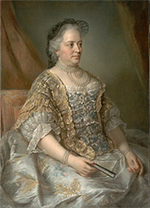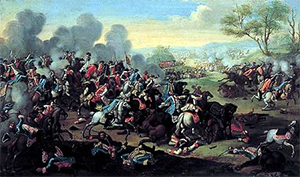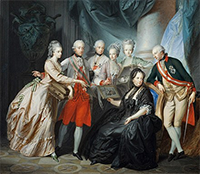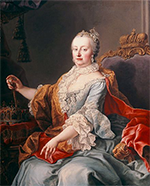Maria Theresa: Holy Roman Empress
Part 2: The Secure Maria Theresa, her throne secured, focused on domestic matters, repairing the damage done by the eight years of fighting. Despite having little formal training, she began to excel at statecraft. Maria Theresa had anticipated that her government and her army needed an overhaul. She tasked Friedrich Wilhelm von Haugwitz with modernizing both. The result of a large standing army and a new system of government, centralized in the Directory, staffed by a large number of government officials. The Directory eventually gave way to the Chancellery and the Council of State. 
The empress instituted financial reforms that filled the state coffers, producing first a balanced budget and then a surplus. She also championed reform of the legal system, overseeing the publication of a criminal code and introducing a court of final appeal known as the Supreme Judiciary. Education was another area in which Maria Theresa introduced reforms, championing literacy and the overall creation of a new system of secular schools. Students in these schools learned not only their mother tongue but also German. The government handed out prizes as incentives to both students and schools. Powering these reforms were a number of newly established teacher training colleges. In stark contrast, the empress proved harsh in relation to religion, pursuing a policy of "conversion" of Protestants to Catholicism and a policy of expulsion for those of the Jewish faith. 
Another conflict began in 1756, one that involved all of Europe and included fighting in far-flung locales as well. England's declaring war on France in that year started things off in the Seven Years War, and Frederick the Great was soon invading Saxony. Maria Theresa, coming to the rescue of Saxony, also found allies in France, Russia, Spain, and Sweden. The 1757 Battle of Kolin was an emphatic victory for this coalition, dispatching one-third of the Prussian army and sending Frederick the Great himself off the fields of battle for a time. He was back, winning at Rossbach in that same year and, three years later, at Torgau. Maria Theresa abandoned her stated desire to reacquire Silesia as the war wound down. The 1763 Treaty of Paris ended the war. Maria Theresa had become a mother in 1737, with the birth of Maria Elisabeth. Two more daughters, Maria Anna (1738) and Maria Carolina (1740) followed. As the war over her succession commenced, she was intent on having a male child so that, she hoped, such strife could be avoided when she passed on her throne. Maria Theresa gave birth to six more children during the eight-year war: Joseph (1741), (a second) Maria Elisabeth (1743), Charles (1745), Maria Amalia (1746), Leopold (1747), and (the second) Maria Carolina (1748). Nowhere near done, she gave birth to five more in the years in between wars: Maria Johanna (1750), Maria Josepha (1751), Maria Carolina (1752), Ferdinand (1754), and Maria Antonia (1755). Her last child, Maximilian Francis (1756), was born during the Seven Years War. 
Not all of these children survived into adulthood. The ones who did became well-known and, in some cases, world famous. Joseph and Leopold both later became Holy Roman Emperor. Maria Christina became Governor of the Austrian Netherlands. Maria Carolina became Queen of Naples and Sicily. Perhaps most famously, Maria Antonia became Queen of France, marrying the future Louis XVI and becoming known as Marie Antoinette. Emperor Francis died on Aug. 18, 1765, adding sorrow to the wedding celebration of his son Leopold. From that point, the oldest surviving son, Joseph, became Holy Roman Emperor, ruling in conjunction with his mother. 
The co-rulers navigated a number of tricky diplomatic situations in the next few decades. Maria Theresa opposed the First Partition of Poland, of which Joseph approved, in 1772. The empire gained Moldavia from the Ottoman Empire in 1775 but lost a large number of soldiers in the War of the Bavarian Succession three years later. Maria Theresa lost a handful of children to smallpox. She herself contracted the disease in 1767 but survived. In her remaining years, she championed inoculation as a means of combating the disease, going so far as to have both herself and two of her children inoculated. She suffered from health problems for the rest of her life. She fell seriously ill on Nov. 24, 1780, and died five days later. First page > The Throne in Doubt > Page 1, 2 |
|
Social Studies for Kids
copyright 2002–2026
David White




